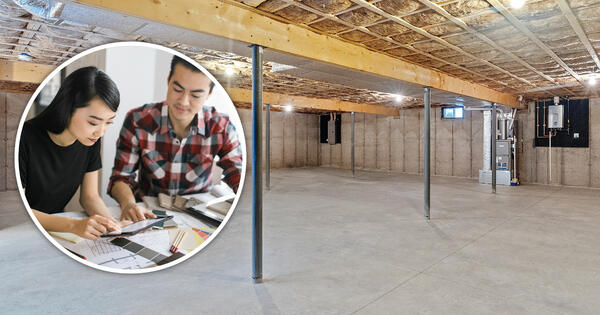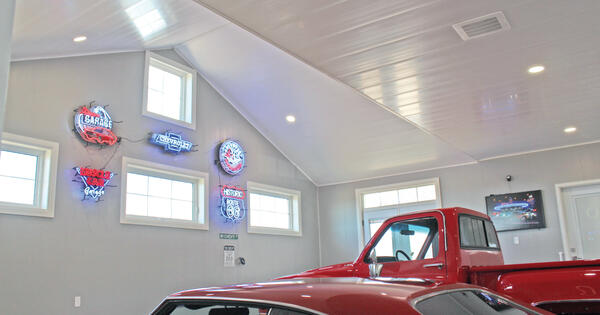This post was originally published in August 2023. Last updated: August 2024.
Finding a stud in your wall is crucial for any project that involves mounting something heavy — whether it’s a TV, a shelf, or a mirror. Securing your object to a stud provides stability and ensures it won’t come crashing down. While stud finders are a popular tool for the job, there are several tried-and-true methods for locating studs without one. In this blog post, we’ll cover both approaches so you can confidently tackle your next wall-mounting project.
Why Finding a Stud Is Important
When you’re tackling a wall-mounting project — whether it's hanging a shelf, mounting a TV, or securing heavy artwork — finding a stud is one of the most crucial steps. Drywall alone isn’t designed to bear heavy loads, so anchoring directly into a stud ensures that the weight is supported by the underlying wooden frame, providing the strength and stability needed to avoid accidents and damage.
Locating a stud also helps you avoid common pitfalls like cracking or breaking drywall, which can happen if you rely solely on anchors or screws in weak spots. Without a stud, even heavy-duty drywall anchors may eventually give way, leading to sagging, loose mounts, or worse — falling objects.
Here’s why safety and stability are so dependent on anchoring to studs:
- Strength: Studs are structural elements of the wall, designed to bear weight. When you mount items to a stud, you're using the full load-bearing capacity of the wall, preventing unexpected failures.
- Damage Prevention: Mounting into drywall can lead to cracks, holes, or long-term damage. This not only compromises the wall’s integrity but may also lead to costly repairs.
- Safety: Securing heavy objects to studs reduces the risk of accidents. For example, a TV mounted improperly could fall and cause injury. Stud-mounting minimizes this risk, keeping you and your home safe.
In summary, finding a stud for wall-mounting projects is all about ensuring the security of your installation, protecting your walls, and maintaining a safe living environment.
Types of Walls and Their Impact on Stud Finding
Different types of walls can make finding a stud easier or more challenging, depending on their construction. The methods you choose to locate a stud will often vary based on what the wall is made of, so understanding the characteristics of each wall type is crucial.
- Drywall: This is the most common wall type and generally the easiest to work with for finding studs. Studs in drywall are usually spaced 16 or 24 inches apart on center, so once you locate one, it’s easier to find the others. Drywall stud finders work effectively, and tapping the wall or using visual cues can help, too.
- Plaster: Older homes often have plaster walls, which are much denser than drywall and may have wood lath behind them. Stud finders designed for plaster walls may not be as effective because the thickness can interfere with the signal. Additionally, the spacing of studs can vary, making them harder to pinpoint without specialized tools.
- Wood Paneling: Wood paneling can make finding studs trickier, as the panels may create a false impression of solidity. The natural texture of wood can also obscure the sounds that tapping typically reveals in drywall. However, paneling is often installed over drywall, so traditional stud-finding methods still apply, but with added complexity.
- Concrete or Brick Walls: These walls generally don’t have studs in the same sense as drywall or plaster walls. Instead, you’ll need to use masonry anchors or bolts for mounting, which changes your approach entirely. There won’t be wooden studs to rely on for support.
Stud location can also be influenced by construction methods. For example, load-bearing walls may have additional studs, while non-load-bearing walls may have fewer. Knocking on the wall to identify changes in density or using a stud finder helps navigate these differences.
Understanding the type of wall you’re dealing with will guide the tools and techniques you use, ensuring you can locate studs reliably, no matter what kind of wall construction you're working with.



Tools Needed for Stud Finding
When it comes to finding studs, having the right tools makes a world of difference. Depending on what you have on hand, you can use a stud finder or alternative tools to get the job done.
- With a Stud Finder: Stud finders are one of the most effective tools for locating studs behind walls. They work by detecting changes in the wall’s density or magnetic fields, helping you pinpoint the exact location of the studs.
- Magnetic Stud Finders: These finders rely on magnets to detect the metal fasteners (like screws or nails) that hold the drywall to the studs. They’re inexpensive and easy to use but may require some trial and error since they only detect the hardware, not the stud itself.
- Electronic Stud Finders: These are more advanced and work by scanning for density changes in the wall material. They can detect the edges of a stud and are often equipped with features that identify both wood and metal studs. Some even include sensors for live wires, adding an extra layer of safety.
- Without a Stud Finder: If you don’t have a stud finder, there are other methods and tools you can use:
- Tape Measure: Measure from a corner or known stud location and mark the wall at regular intervals (usually 16 or 24 inches).
- Hammer and Small Nail: Lightly tap a small nail into the wall to test for the presence of a stud. If the nail hits solid wood, you've found your stud.
- Flashlight: Shine a flashlight at an angle along the wall. Sometimes you can spot small imperfections or depressions that mark where nails or screws are placed over studs.
Whether you’re using a stud finder or an alternative method, having the right tools will make locating studs easier and more reliable.
How to Find a Stud Using a Stud Finder
Using a stud finder is one of the most straightforward ways to locate studs. Here’s how to use both magnetic and electronic types:
Magnetic Stud Finder
- Prep the Surface: Make sure the wall is clean and free of any debris that could interfere with the tool.
- Move Slowly: Glide the magnetic stud finder along the wall, moving slowly in a horizontal direction.
- Feel for Resistance: The magnet will be drawn toward the fasteners in the stud. When you feel the pull, you’ve found a metal screw or nail holding the drywall in place, indicating the stud's location.
- Mark the Spot: Once you’ve located the fastener, mark the spot with a pencil.
Electronic Stud Finder
- Calibrate: Most electronic stud finders need calibration. Hold the device flat against the wall and press the calibration button until it beeps or the light stays steady.
- Scan the Wall: Slowly move the stud finder horizontally across the wall. It will beep or light up when it detects the edge of a stud.
- Mark the Edges: Mark both edges of the stud. The center of the stud is located between the two marks.
- Repeat the Process: Continue scanning along the wall to confirm the stud’s exact location and the spacing of other studs.
Tips for Accuracy
- Avoid False Readings: Make sure to keep the stud finder flat against the wall without tilting it, and move slowly to avoid missing the stud.
- Troubleshooting: If your stud finder isn’t detecting anything, try recalibrating it in a different area. Also, make sure you’re not near any metal pipes or wiring that could interfere with the reading.
How to Find a Stud Without a Stud Finder
If you don’t have a stud finder, there are a few reliable techniques you can use to find studs. Here are some tried-and-true methods:
- Knocking Method: Tap lightly on the wall with your knuckles or a small hammer, moving horizontally along the wall. You’re listening for changes in the sound — when you knock over a stud, the sound will become more solid or dull compared to the hollow sound between studs. While this method can be helpful, it’s not always precise, so it’s best to use it alongside other techniques.
- Electrical Outlets and Light Switches: Electrical outlets and light switches are typically mounted on the sides of studs. To use this method, remove the cover plate from an outlet or switch, then look inside to see which side the stud is on. From there, measure out 16 or 24 inches to locate the next stud. This method works well because electrical boxes are usually attached directly to a stud.
- Measuring from Corner: Most studs are spaced 16 or 24 inches apart, measured from the center of the stud. To estimate the location of studs, measure from a corner of the room or a known stud. If you start from a corner and measure 16-inch intervals, you should be able to locate studs even without specialized tools. This method assumes that the wall was constructed using standard building practices.
- Using a Magnet: A strong magnet can help you find the nails or screws that attach drywall to the studs. Slide the magnet slowly across the wall’s surface, and when it sticks, you’ve likely found a nail or screw. You may need to test several areas before identifying the stud location, but once you find one, the others should follow a predictable pattern.
By combining these techniques, you can confidently locate studs in your walls even if you don’t have a stud finder handy.
Common Challenges When Finding Studs
Finding studs can sometimes be trickier than expected. Even with the right tools, you might run into a few challenges that can complicate the process. Whether it’s due to inconsistent spacing, false readings, or hidden obstacles, being aware of these potential issues and knowing how to handle them can save you time and frustration.
Here are some common challenges that might arise during stud finding:
| Challenge | Why Is It an Issue? | How Do I Solve It? |
|---|---|---|
| Inconsistent Stud Spacing |
Although studs are typically spaced 16 or 24 inches apart, that isn’t always the case. In older homes, for example, stud spacing might be irregular due to different construction practices. Additionally, corners, windows, and doors can affect spacing, making it harder to predict where studs are located. |
If you’re not finding studs at the typical 16- or 24-inch intervals, measure again from a known stud or corner and check different areas of the wall. Using multiple methods — like a stud finder combined with measuring from an outlet — can help locate hidden studs. |
| False Readings from Stud Finders | Electronic stud finders can sometimes give false positives. This might happen if the stud finder detects changes in the wall’s density due to pipes, electrical wires, or even variations in the drywall thickness. It can also occur if you’re moving the finder too quickly or tilting it while scanning. | To minimize false readings, make sure you’re moving the stud finder slowly and keeping it flat against the wall. If the readings seem inconsistent, try using a magnetic stud finder as a backup method. Additionally, recalibrating your stud finder in a different spot might help reset it for a more accurate reading. |
| Obstacles Behind the Wall | Pipes, electrical wires, and ductwork can create interference during the stud-finding process. These obstacles often run through walls and can throw off readings from stud finders. Worse, drilling into them can cause damage to your home or pose a safety hazard. | Before drilling, always double-check for pipes and wires by using a stud finder with electrical or metal detection capabilities. If you suspect an obstacle, scan the area multiple times and in different directions to confirm whether it’s a stud or something else. When in doubt, avoid drilling in that area. |
By staying aware of these potential issues and employing a few extra precautions, you’ll increase your chances of successfully locating studs without running into trouble.
What to Do If You Can’t Find a Stud
Sometimes, despite your best efforts, you just can’t find a stud in the right location. If that’s the case, you don’t have to give up on your project. There are several heavy-duty drywall anchors and mounting solutions that provide the strength and security you need to hang items safely — even without a stud.
Here are some reliable alternatives for mounting when a stud isn’t available:
- Toggle Bolts: Toggle bolts are one of the strongest options for anchoring into drywall. They work by expanding a set of metal wings behind the drywall, which distributes the weight across a larger area. Toggle bolts are great for heavy objects like shelves or mirrors, and they can support significant weight if installed properly.
- Molly Bolts: Molly bolts are designed to spread the load over a larger area of the drywall. Once inserted into the wall, the bolt’s sleeve expands, creating a strong hold. Molly bolts are ideal for medium-weight items, such as picture frames or small shelves.
- Self-Drilling Drywall Anchors: These anchors are easy to install and don’t require pre-drilling. They can support moderate weights but may not be as reliable as toggle or molly bolts for very heavy items. They’re a good option for lighter fixtures like curtain rods or small decorations.
- Wall Dog Screws: Wall dogs are versatile screws designed to anchor directly into drywall without the need for additional hardware. They offer strong support and are easy to use, making them suitable for medium-weight installations like light shelving or coat hooks.
When using these solutions, always check the weight limit of the anchor and ensure it’s suitable for your specific item. If you’re unsure, err on the side of caution by using a stronger anchor or redistributing the weight across multiple points of support.
Even if you can’t find a stud, with the right anchor, you can still complete your project securely and confidently.

Installing Trusscore Wall&CeilingBoard on Studs
Trusscore Wall&CeilingBoard panels are 16 inches wide, regardless of length, making them the perfect width for installing directly to studs. However, Trusscore Wall&CeilingBoard can also be installed directly on top of drywall, and you’ll need to take some of the steps outlined in this blog post to detect the studs behind it.
If you’re installing Trusscore Wall&CeilingBoard on studs spaced 24 inches apart, we recommend installing the panels horizontally across the wall.
And if you want to mount, hang, or fasten items to your Trusscore Wall&CeilingBoard installation, there are some special considerations to make:
- When hanging an item directly on a Trusscore Wall&CeilingBoard panel, items should never be directly fastened without back support from a stud.
- Lightweight items (i.e., less than 30 pounds) can be attached directly to Trusscore Wall&CeilingBoard using adhesive hooks such as Command™ Hooks or using spring toggle bolt kits.
- Moderate-weight items should be fastened directly to the supporting structure of the wall or ceiling through Trusscore Wall&CeilingBoard. Mounting holes should be slightly oversized to accommodate for expansion and contraction of the panel.
- Heavyweight items should be mounted directly to the supporting structure to avoid crushing your Trusscore Wall&CeilingBoard panels. We recommend completely cutting out Trusscore Wall&CeilingBoard from the mounting area.
For more information, download the comprehensive Trusscore Wall&CeilingBoard installation guide.
Whether you’re using a stud finder or opting for a manual method, there’s no reason you can’t find a stud in your wall with a bit of patience and the right approach. While stud finders are convenient, alternative methods can work just as well. Remember to always secure heavy items properly to avoid damage and ensure your safety.






